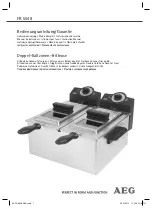
Installing and connecting the appliance
en
15
Connecting the appliance
:
Warning
Risk of electric shock/fire/material
damage/damage to the appliance!
If the appliance is not installed properly,
this may lead to a dangerous situation.
Ensure the following:
■
The mains voltage on your power
socket must match the rated voltage
specified on the appliance
(identification plate). The connected
loads and the required fuse
protection are specified on the
identification plate.
■
The appliance must only be
connected to alternating voltage via
a protective contact socket that has
been correctly installed. This plug
socket must be freely accessible at
all times.
■
The mains plug and the protective
contact socket must match and the
earthing system must be correctly
installed.
■
The installation must have an
adequate cross section.
■
The mains plug must be freely
accessible at all times. If this is not
possible, in order to comply with the
relevant safety regulations, a switch
(2-pole switch-off) must be built into
the permanent installation in
accordance with electrical
installation regulations.
■
If using a residual current circuit
breaker, only use one that bears the
following mark:
z
. The presence of
this mark is the only way to be sure
that it fulfils all the applicable
regulations.
:
Warning
Risk of electric shock/fire/material
damage/damage to the appliance!
If the appliance's mains cable is altered
or damaged, this may result in electric
shock, short circuiting or fire due to
overheating.
The mains cable must not be kinked,
crushed or altered, and must not come
into contact with any heat sources.
:
Warning
Risk of fire/material damage/damage
to the appliance!
The use of extension cords or power
strips may result in fire due to
overheating or short circuiting.
Connect the appliance directly to an
earthed socket that has been correctly
installed. Do not use extension cords,
power strips or multi-way couplers.
:
Warning
Risk of injury!
If the hoses and mains cables are not
correctly routed, they may constitute a
tripping hazard, which may result in
injury.
Route hoses and cables such that they
do not constitute a tripping hazard.
















































